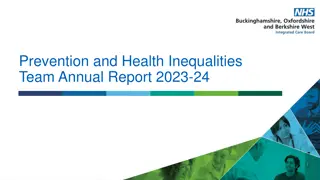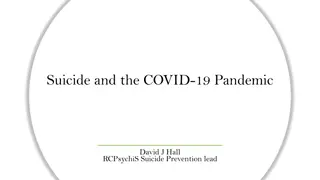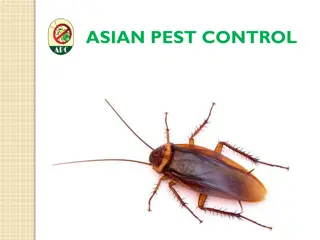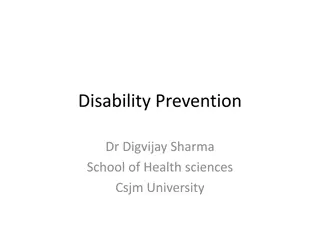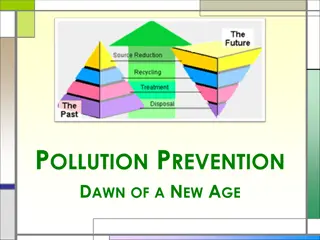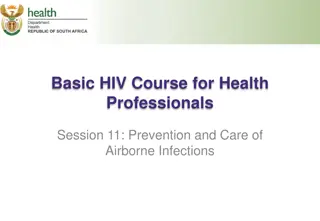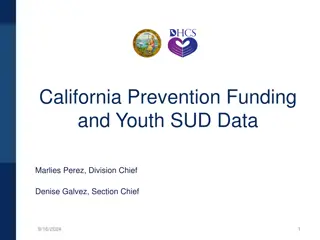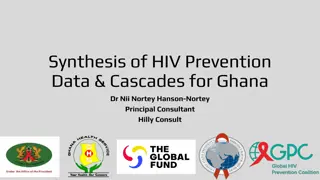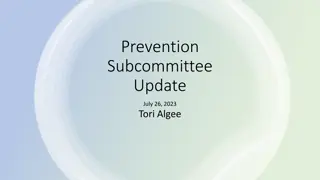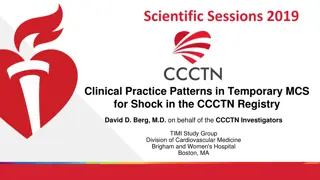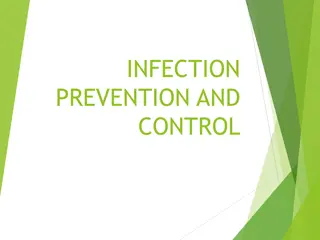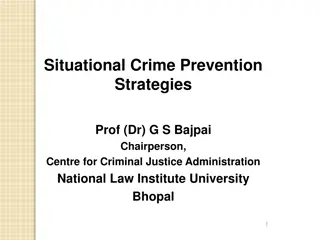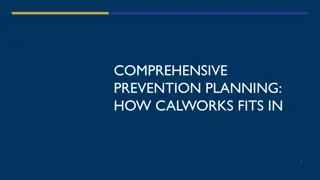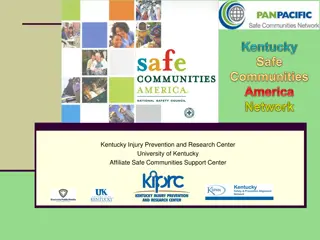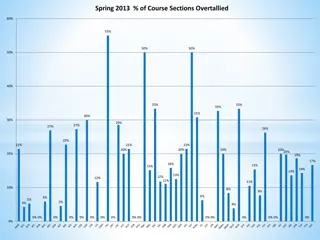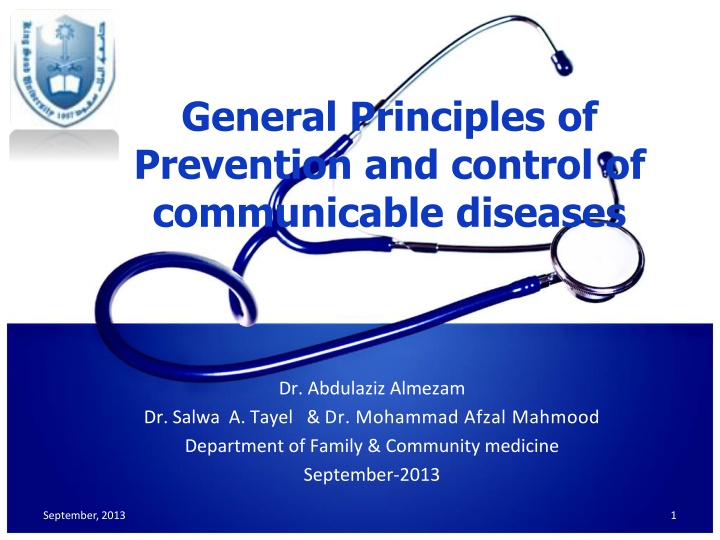
Principles of Prevention and Control of Communicable Diseases
Explore the general principles of prevention and control of communicable diseases, covering measures towards reservoirs, MOT/environment, contacts, and susceptible hosts. Learn about the levels of disease prevention, including primary, secondary, and tertiary prevention, along with the concepts of eradication, elimination, and control of diseases.
Download Presentation

Please find below an Image/Link to download the presentation.
The content on the website is provided AS IS for your information and personal use only. It may not be sold, licensed, or shared on other websites without obtaining consent from the author. If you encounter any issues during the download, it is possible that the publisher has removed the file from their server.
You are allowed to download the files provided on this website for personal or commercial use, subject to the condition that they are used lawfully. All files are the property of their respective owners.
The content on the website is provided AS IS for your information and personal use only. It may not be sold, licensed, or shared on other websites without obtaining consent from the author.
E N D
Presentation Transcript
General Principles of Prevention and control of communicable diseases Dr. Abdulaziz Almezam Dr. Salwa A. Tayel & Dr. Mohammad Afzal Mahmood Department of Family & Community medicine September-2013 September, 2013 1
OBJECTIVES OF THE LECTURE OBJECTIVES OF THE LECTURE By the end of this lecture you will be able to: o Identify measures for prevention and control of communicable diseases Measures towards reservoir Measures towards the MOT /environment Measures to contacts and susceptible host Identify the levels of prevention of diseases o 2 2 September, 2013
Prevention Actions aimed at eradicating, eliminating, or minimizing the impact of disease and disability, or if none of these is feasible, retarding the progress of disease and disability. The concept of prevention is best defined in the context of levels of prevention; primary, secondary, and tertiary prevention. (Oxford Dictionary 2008) September, 2013 3
Control of disease CONTROL: Disease incidence is reduced to a minimal level, acceptable at the level of country/region, at which the disease is no longer considered a public health problem, while infection may still occur. 4 September, 2013
Control of disease 5 September, 2013
Control of disease 6 September, 2013
Control of disease 7 September, 2013
Elimination of disease ELIMINATION: Reduction to zero of the incidence of a specified disease in a defined community or country or region as a result public health actions. In 1988, polio paralyzed more than 350 000 people a year. Since that time, polio case numbers have decreased by more than 99% (with only 406 polio cases reported in 2013). 8 September, 2013
MeaslesCase 9 September, 2013
Measles Case 10 September, 2013
Eradication It means worldwide disappearance of a disease i.e. (permanent reduction to zero level) : The organism may be present only in laboratories, but there is no need for public health actions. e.g. smallpox since 1979. 11 September, 2013
Polio Cases 12 September, 2013
Polio Cases 13 September, 2013
Polio Cases 14 September, 2013
Polio Cases 15 September, 2013
Polio Eradication Campaign 16 September, 2013
Countries reporting Poliovirus 2000 17 September, 2013
Global distribution of Polio 18 September, 2013
Cycle of infection and interventions applied at each link The cycle of infection has three major links: Reservoir& source Mode of transmission Susceptible Host In general, control measures should be directed towards the link in the infection chain is most susceptible to interference. September, 2013 19
Cycle of infection and interventions applied at each link -Surveillance/quarantine -Chemoprophylaxis -Sero-prophylaxis -Vaccination -Isolation of cases -Treatment -Disinfection -Control of carriers -Control of animals Host Reservoir& Source Mode of transmission -Prevention of overcrowding -Personal hygiene -Vector control -Environmental sanitation September, 2013 20
Interventions to break the cycle of infection Interventions to break the cycle of infection The best control measures to the first link, the reservoir are: Aim of control the reservoir or source of infection is to reduce the quantity of the agent by isolation, treatment of cases, control of carriers and animal reservoir The best control measures to the second link, MOT are: to interrupt the transmission from source of infection to the susceptible host. Examples are: Vector control, Snail control and improvement of Environmental sanitation. The best means of control to the third link (the host) are: to improve the defense by making sure that people have adequate nutritional status, have no or few concomitant diseases that decrease the immunity, and by improving immunity through vaccination, chemoprophylaxis. 21 September, 2013
Measures towards Reservoir Objective of control measures towards reservoir Reduce quantity of agent (complete or partial reduction) Reduce communicability Measures towards cases Measures towards carriers Measures towards animal reservoir September, 2013 22
Measures towards cases Case finding (early detection/screening) Reporting Segregation /isolation of cases Treatment of cases Disinfection 23 September, 2013
Measures towards cases Segregation/Isolation of cases This means that the patient is isolated from the community in a fashion that prevents direct or indirect spread of infectious agents. Isolation is usually done for a period which equals the period of communicability at a hospital (fever hospital) or at home. Ideally repeated negative sample are needed before his release. 24 September, 2013
Measures towards cases Treatment of cases Early diagnosis and prompt treatment of infections with appropriate regimens (e.g. antibiotics, antiviral or other chemotherapeutic agents) helps reducing communicability. 25 September, 2013
Measures towards cases Disinfection -Concurrent -Terminal Disinfection of the soiled articles by the patient discharges or excreta concurrently (during his presence as source of infection) and/or terminally (after his discharge from the hospital or death) helps in reduction of communicability. Disinfection of contaminated objects with appropriate enteric precautions, respiratory precautions, universal precautions September, 2013 26
Measures applied to carriers 1. Detection of carriers: If they represent important reservoir of infection. If they were suspected in a closed community, such as boarding schools, army barracks, food handling places, .. 2. Exclusion from work: in certain occupations for example; food handler (e.g. Typhoid carrier) or a teacher (e.g. Diphtheria carrier). 3. Treatment for the carrier state (when applicable). 27 September, 2013
Measures applied to animal reservoir Inspection and slaughtering of infected animals (in bovine tuberculosis) Testing and immunization of uninfected sheep, cattle (in brucellosis) Careful husbandry and sterilization of animal products (in anthrax). Extinction/Destruction of animal reservoir has been successful with diseases as rabies and bovine TB in several countries. Such procedure is only possible for domestic animals while it is difficult or almost impossible for wild animals (e.g. in jungle yellow fever, .) 28 September, 2013
Measures to Contacts/ susceptible Host Surveillance/observation Quarantine Increasing resistance of susceptibles September, 2013 29
Measures to Contacts/ susceptible Host Surveillance means close medical supervision of the contacts, without restricting their movement, for the purpose of early detection of the disease in question. Surveillance should be done for duration of the longest incubation period of the disease counted from date of last exposure. September, 2013 30
Quarantine Quarantine means separation (with restriction of the movement) in a specific place (quarantine) of apparently well persons or animals who have been exposed (contact) to a case of infectious disease. Quarantine is done for the duration of the longest incubation period of the disease counted from date of last exposure. It allows early detection of the disease among these individuals. This measure is applied for contacts of pneumonicplague and pneumonic anthrax. 31 September, 2013
Increasing resistance of susceptibles Measures to improve the defense mechanism of the host by using: Chemoprophylaxis, Sero-prophylaxis, Immunization (next lecture). 32 September, 2013
Increasing resistance of susceptibles a) Chemoprophylaxis: The administration of a chemical, including antimicrobials, to prevent the development of an infection (if given before exposure) or to slow progression of the disease to active clinically manifest disease (if given after exposure). 33 September, 2013
Increasing resistance of susceptibles Chemoprophylaxisis used for travelers to endemic areas, occupationally exposed persons (e.g. Health Care Workers) and for contacts in closed communities as in camps, schools and institutions. Examples: 1. Isoniazid (INH) for contacts of tuberculous cases. 2. Rifampicin for contacts of meningeococcal meningitis. 3. Chloroquine for travelers to malaria areas. 34 September, 2013
Increasing resistance of susceptibles b) Sero-prophylaxis: prophylaxis using ready-made antibodies also known as passive immunization (e.g. measles immunoglobulin and tetanus anti tetanic serum (ATS) In case of measles, if it is given within the first three days of the incubation period, it prevents the attack and gives immunity for 4-5 weeks. If administered from the 4th to the 10th day of IP, the subject gets a modified attack and permanent immunity. 35 September, 2013
Increasing resistance of susceptibles c) Vaccination (Active immunization): Protection of susceptible host from communicable diseases by the administration of a modified living infectious agent, killed organism, or inactive agent or part of the agent. 36 September, 2013
Measures towards the environment Reduction of overcrowding (better housing conditions, proper ventilation) Personal hygiene (cleanliness, hand washing, regular bathing) Environmental sanitation: (e.g. sanitary sewage disposal, sanitary refuse disposal, safe water supply, ) 37 September, 2013
Measures towards the environment Vector control (insecticides, indoor or aerial spraying, mosquito-nets, .. National and international measures: which include different public health measures undertaken within and between countries in order to protect the individuals and communities from communicable diseases. 38 September, 2013
Cycle of infection and interventions applied at each link -Surveillance/quarantine -Chemoprophylaxis -Sero-prophylaxis -Vaccination -Isolation of cases -Treatment -Disinfection -Control of carriers -Control of animals Host Reservoir& Source Mode of transmission -Prevention of overcrowding -Personal hygiene -Vector control -Environmental sanitation September, 2013 39
Choice of appropriate prevention & control measures The choice of the control measure is disease dependent. It depends upon the knowledge of: Natural history, causation and dynamics of disease transmission identification of risk factors and high risk groups availability of tools of intervention (vaccine chemoprophylaxis or treatment,..) September, 2013 40
Levels of Prevention Primary prevention => pre-event phase Secondary prevention => event phase Tertiary prevention => post-event phase Health Promotion (1ry prevention) Early detection & care (2ry prevention) Rehabilitation (3ry prevention) 41 September, 2013
Natural History of Disease Detectable subclinical disease Clinical Disease Outcome: Subclinical Disease Susceptible Host Stage of Recovery, Complications, Disability, or Death Diagnosis sought Point of Exposure Tertiary Prevention Primary Prevention Onset of symptoms Secondary Prevention (Screening) September, 2013 42
I- Primary Prevention: Actions taken prior to the onset of the disease which aim to remove the possibility that a disease will ever occur It limits the incidence of diseases by preventing healthy people from developing disease. Primary Prevention activities can be directed at individuals or at the environment. September, 2013 43
At individual level Measures to improve the general health of the individuals: 1. Health education efforts are directed at encouraging people to develop good health habits (Adequate nutrition, exercise) and to adopt hygienic practices (hand washing, . 2. Specific protective measures such as, chemoprophylaxis, sero-prophylaxis, vaccination September, 2013 44
At environmental level Environmental sanitation is used to provide an adequate sewage system, safe drinking water, clean air and proper ventilation. 45 September, 2013
II- Secondary Prevention: It is the early detection and prompt treatment of a disease, thus hinder the progress of a disease and prevent complications. i.e. intervention in early pathogenesis phase. Measures of secondary prevention include: 1. Screening programs are used to detect diseases at early preclinical stages, when effective therapy may either cure the disease or limit its progression 2. Primary medical care: through early case finding at PHCC. It is the predominant form of secondary prevention. 46 September, 2013
III- Tertiary prevention: Actions taken when the disease process has advanced beyond its early stages i.e. intervention in late pathogenesis phase. The aim of tertiary prevention is limitation of disability and rehabilitation from disease. Tools for tertiary prevention include rehabilitation 47 September, 2013
Rehabilitation includes: 1. Medical rehabilitation restoration of function or physical loss. 2. Educational rehabilitation change of educational methods. 3. Vocational (occupational) rehabilitation restoration of the capacity to earn a livelihood. 4. Social rehabilitation: restoration of family and social relationships. 5. Psychological rehabilitation: restoration of personal confidence. 48 September, 2013
Examples of uses of levels of prevention All three levels of prevention can be used to control a single disease process. 1. BCG Vaccination of newborns (primary prevention). 2. Screening and early treating a person with active tuberculosis (secondary prevention) may prevent transmission to another person (primary prevention). 3. In advanced cases of tuberculosis, occupational and social rehabilitation (tertiary prevention) by modification of working conditions may help to regain the capacity to earn his livelihood. September, 2013 49
Reference books Reference books - Walter R Dowdle. The Principles of Disease Elimination and Eradication. December 31, 1999 / 48(SU01);23-7. Available at: http://www.cdc.gov/mmwr/preview/mmwrhtml/su48a7.htm Heymann D. Control of communicable diseases manual. Washington DC: American Public Health Association, 2008. Principles of Epidemiology in Public Health Practice. Third Edition. An Introduction to Applied Epidemiology and Biostatistics. Centers for Disease Control and Prevention (CDC) Beaglehole R, Bonita R, Kjellstrom T. Basic epidemiology. 2nd edition. Geneva: World Health Organization, 2006 - - - September, 2013 50


